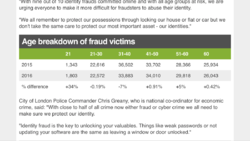Tin Pot
Guru
Some interesting fraud stats from ONS
What is known about the nature and circumstances of fraud?
Analysis of the Crime Survey for England and Wales (CSEW) experimental statistics on fraud and computer misuse revealed additional information about the nature of such incidents:
The large majority of victims of fraud had been a victim only once (84%), although repeat victimisation (within the same 12 month crime reference period) was more common among victims of bank and credit account fraud (14%) than other types of fraud (Experimental table E9).
Almost two-thirds of fraud incidents involved initial loss of money or goods to the victim (62%), independent of any reimbursement received1. This equates to an estimated 2.3 million offences, compared with 1.4 million incidents of fraud involving no loss.
Victims received a full reimbursement in 43% of fraud incidents (1.6 million), typically from their financial provider. In 690,000 cases, the victim received no or only partial reimbursement (Experimental table E5).
Where money was taken or stolen from the victim, in just under two-thirds of incidents the victim lost less than £250 (64%) (Experimental table E6).
Incidents of bank and credit account fraud were more likely to result in initial loss to the victim (70%, equivalent to 1.7 million) than other types of fraud. In the majority of these incidents, the victim received a full reimbursement (84%).
In 49% of non-investment frauds (such as fraud related to online shopping scams or fraudulent computer service calls) and 76% of all other frauds (for example, lottery scams, pyramid or Ponzi schemes2 or charity fraud) there was no loss to the victim. This compares to 30% of incidents of bank and credit account fraud where no loss was suffered.
With regard to computer misuse, 22% of incidents involved loss of money or goods, all relating to computer viruses (442,000 incidents)3.
The extent of cyber crimes4 varied by type of offence. As expected, almost all computer misuse offences (97%) involved the use of the internet in some way (compared to 3% where the internet was not involved), while it was reported to have been involved in less than half of all bank and credit account frauds (43%) (Experimental table E12).
Among cyber crimes, bank and credit account frauds were more likely to involve the use of the internet in some way (56%) than non-investment frauds (40%) or advance fee frauds (4%).
What is known about the nature and circumstances of fraud?
Analysis of the Crime Survey for England and Wales (CSEW) experimental statistics on fraud and computer misuse revealed additional information about the nature of such incidents:
The large majority of victims of fraud had been a victim only once (84%), although repeat victimisation (within the same 12 month crime reference period) was more common among victims of bank and credit account fraud (14%) than other types of fraud (Experimental table E9).
Almost two-thirds of fraud incidents involved initial loss of money or goods to the victim (62%), independent of any reimbursement received1. This equates to an estimated 2.3 million offences, compared with 1.4 million incidents of fraud involving no loss.
Victims received a full reimbursement in 43% of fraud incidents (1.6 million), typically from their financial provider. In 690,000 cases, the victim received no or only partial reimbursement (Experimental table E5).
Where money was taken or stolen from the victim, in just under two-thirds of incidents the victim lost less than £250 (64%) (Experimental table E6).
Incidents of bank and credit account fraud were more likely to result in initial loss to the victim (70%, equivalent to 1.7 million) than other types of fraud. In the majority of these incidents, the victim received a full reimbursement (84%).
In 49% of non-investment frauds (such as fraud related to online shopping scams or fraudulent computer service calls) and 76% of all other frauds (for example, lottery scams, pyramid or Ponzi schemes2 or charity fraud) there was no loss to the victim. This compares to 30% of incidents of bank and credit account fraud where no loss was suffered.
With regard to computer misuse, 22% of incidents involved loss of money or goods, all relating to computer viruses (442,000 incidents)3.
The extent of cyber crimes4 varied by type of offence. As expected, almost all computer misuse offences (97%) involved the use of the internet in some way (compared to 3% where the internet was not involved), while it was reported to have been involved in less than half of all bank and credit account frauds (43%) (Experimental table E12).
Among cyber crimes, bank and credit account frauds were more likely to involve the use of the internet in some way (56%) than non-investment frauds (40%) or advance fee frauds (4%).




